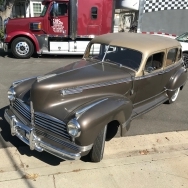Proving the correct temp sender for my 1942 eight
My car is a 1942 Commodore 8. The temperature gauge is seemingly inaccurate. Starting cold, it quickly rises to operating temperature of 1/2 (thats good).
With a 160 thermostat it goes to 3/4 on a hot day pulling hill or in traffic it can go past 3/4 hitting the full hot mark.
I have used a thermometer in the radiator neck and at 3/4 it is at 180 degrees.
It has a new radiator and the system is clean of rust. It doesn't really act like it is too hot, but I would think that 180 degrees would be at the1/2 mark. When the needle goes to full it is scary.
How do you test or calibrate the sending unit based on temperature?
How do you determine if I have the correct sending unit?
How do you choose the correct sending unit if I find one for sale?
With a 160 thermostat it goes to 3/4 on a hot day pulling hill or in traffic it can go past 3/4 hitting the full hot mark.
I have used a thermometer in the radiator neck and at 3/4 it is at 180 degrees.
It has a new radiator and the system is clean of rust. It doesn't really act like it is too hot, but I would think that 180 degrees would be at the1/2 mark. When the needle goes to full it is scary.
How do you test or calibrate the sending unit based on temperature?
How do you determine if I have the correct sending unit?
How do you choose the correct sending unit if I find one for sale?
0
Comments
-
The sending unit and gauge are bi-metal types, so you do not get a varying resistance, just faster make-and-break intervals. The mech. procedures manual does give a description of how to test, but to follow this you must have a unit that is known to be good, according to the instructions. My advice would be to beg, borrow or steal a heat sensor gun, and check the temp at various readings, and live with it, knwoing the variation between what the heat gun tells you and the gauge reading. However, if you want you could experiment with resistances, starting at 10 ohms (wire-wound ceramic), between the sender and gauge, and see what happens.0
-
"The sending unit and gauge are bi-metal types, so you do not get a varying resistance, just faster make-and-break intervals"
OMG I would never have guessed. . . . ! No wonder I am having difficulty understanding.
Of course this means that there is no modern new replacement.
"Mechanical procedures" manual(?) I have the Shop manual, is there another book?
Thank you.
0 -
Same thing!0
-
Hudson manuals are just not the same as the FoMoCo manuals I have been reading for decades.
I was looking at the diagrams in the electrical section. I would never have guessed that the water gauge was in the cooling system chapter and the gas gauge is in the fuel system chapter.0 -
Hudson always did things different!0
Categories
- 36.6K All Categories
- 85 Hudson 1916 - 1929
- 11 Upcoming Events
- 73 Essex Super 6
- 28.3K HUDSON
- 511 "How To" - Skills, mechanical and other wise
- 989 Street Rods
- 150 American Motors
- 170 The Flathead Forum
- 47 Manuals, etc,.
- 71 Hudson 8
- 40 FORUM - Instructions and Tips on using the forum
- 2.7K CLASSIFIEDS
- 592 Vehicles
- 2.1K Parts & Pieces
- 76 Literature & Memorabilia
- Hudson 1916 - 1929 Yahoo Groups Archived Photos

